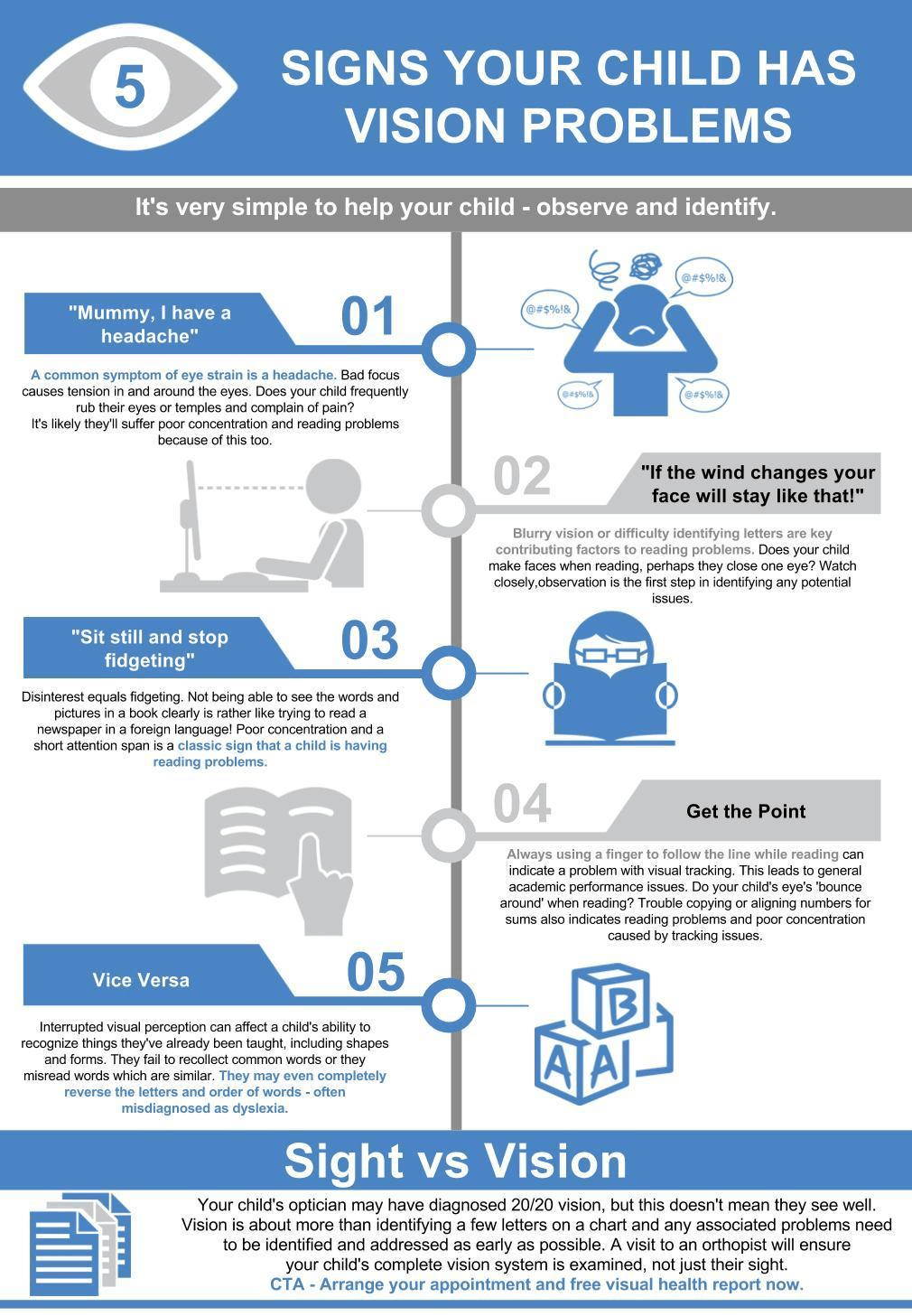Paediatric Eye Problems
What is Paediatric Eye Examination?
Paediatric Eye Examination (also Child Eye Examination) is a procedure that allows the examination of a child's eye. This includes testing for:
- Strabismus (squint, turned eye, lazy eye) one of the eyes or both eyes is turning in a different direction
- Amblyopia (reduced vision)
- Convergence Insufficiency
- Double vision, Eye strain
- Blurred or Low Vision
- Visual Perception
- Eye Tracking
Paediatric Eye Examination
A Paediatric Eye Examination is usually performed to evaluate clinical symptoms or other observed vision problems.
A Paediatric Eye Examination can detect early problems and offers an accurate means of detecting the causes and possible treatments for your child's eye disease.

Common Children's Eye Problems
Strabismus (Squint)
A squint occurs when the two eyes are not pointing in the same direction. Most commonly, one eye will turn in or out, but sometimes one eye could be sitting higher than the other. A squint can be present from birth or develop later in childhood. In some children, the eye will turn all the time (constant squint); in others, it will sometimes turn (intermittent squint). An intermittent squint is usually more noticeable when the child is tired or looking far away or close up.
The turned eye could lead to amblyopia or 'lazy eye' because the brain may be underdeveloped for vision in the turned eye. The lazy eye is usually treated by patching the stronger eye to strengthen the vision in the turned eye.
Sometimes glasses could help straighten the eyes. Once the lazy eye is treated, the eye could be straightened by surgery. Surgery only improves the alignment of the eyes and does not improve the vision. Squint surgery is usually done under general anaesthetic as a day procedure. This is usually well tolerated, even in young children.
Lazy Eye (Amblyopia)
Lazy eye (amblyopia) occurs when there is an interruption in the normal visual development during early childhood. This results in reduced vision in the lazy eye. The common causes include
- a squint (a turned eye)
- refractive error (the need to wear glasses)
- or obscuration of vision by, for example, a droopy eyelid
It is essential to treat the lazy eye before the age of seven or eight as the treatment outcome is better. The treatment is usually in the form of patching over the stronger eye, sometimes, glasses are needed to sharpen the focus, and occasionally eye drops could be used to blur the vision in the better eye.
Refractive Error
It is usual for children to be long-sighted. Long-sightedness means children must strain to focus both at a distance and near. Most children can see well despite long-sightedness as they have a great ability to change focus with their eyes. However, some children have a significantly high degree of long-sightedness, causing blurred vision. This could then lead to a lazy eye. Glasses may then be required to assist normal visual development.
Sometimes children are short-sighted, and depending on age and the degree of short-sightedness, glasses may be necessary.
Astigmatism occurs when the shape of the eyeball is more like a rugby ball rather than like a soccer ball. This results in blurred vision at all distances. Significant degrees of astigmatism can lead to lazy eyes, and once again, glasses may be required.
To check refraction in children accurately, eye drops are required to dilate the pupils.
Blocked Tear Ducts
Blocked tear ducts are a common condition in the population. Children with blocked tear ducts have watery eyes since birth. The lids could be stuck together, and often, there is a yellow discharge around the inner corner of the eye. However, the white of the eye should not be red.
Most children with blocked tear ducts get better spontaneously without treatment by twelve months. If the blocked tear ducts persist after one year, a surgical procedure may be needed to unblock the tear ducts under a short general anaesthetic.
Chalazion
Within the eyelid, many small meibomian glands produce an oily fluid that forms part of the tears.
A Chalazion is formed when the draining ducts of the meibomian glands are blocked. This causes localised swelling and inflammation in the eyelid. It is common to have multiple chalazia involving both the top and bottom eyelids. Most chalazia go away with warm compression over eyelids.
If the lump persists, this can be excised surgically, usually under a short general anaesthetic.
Ready for Consultation?
About Us

Specialist medical and surgical eye care for adults and children for eye disease management
Quick Links
Services Offered
Get in Touch
Telephone: (02) 9868 2333
Fax: (02) 9876 4359
Email: admin@eppingeye.com
Address: 40 Essex St. Epping NSW 2121






